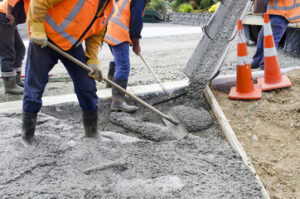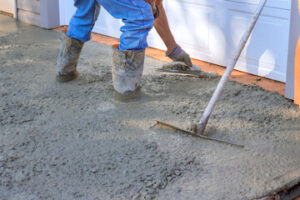Concrete services are an essential part of the construction industry. They help in the development of durable and sturdy structures that can withstand heavy traffic and harsh weather conditions.

Their responsibilities include project planning, site preparation, concrete pouring, finishing, and quality control. They also perform repairs and maintenance on existing concrete structures.
Concrete is often installed near buildings, such as a driveway next to a home or a sidewalk outside of a storefront. However, before any concrete can be poured, it’s important to evaluate several factors around the construction site. This process is called site preparation, and it helps ensure that the future concrete will stay in good condition.
The first step of any site preparation project is clearing the area. This involves tearing down existing structures and removing any trees or other obstructions from the site. This can be a time-consuming and messy task, but it’s crucial for the success of any construction project. If the site isn’t cleared properly, it could affect the construction process and even lead to safety risks for everyone involved.
Once the site has been cleared, it’s time to begin the actual grading process. This includes laying a base of gravel or crushed rock to help with drainage and to provide support for the future concrete. It also involves preparing for utility rough-ins by digging trenches where necessary utilities will be placed. This is essential to avoid any issues with underground pipes bursting, which can be very dangerous and expensive.
While it is possible to perform some of the site preparation work on your own, hiring a professional service can save you a lot of time and money. They have the skills and equipment to get the job done quickly and efficiently, and they will be able to identify any potential problems before they become an issue. This can save you a lot of headaches down the road and ensure that your concrete project is completed successfully.
Pouring
Concrete services are pivotal in modern construction, providing essential solutions for residential and commercial projects. From foundations to decorative finishes and repair work, concrete contractors are equipped with the knowledge and expertise to ensure that each project is completed according to industry standards and offers long-lasting, durable results.
In the beginning stages of any concrete project, contractors must collaborate with architects and engineers to create detailed blueprints and construction plans for the desired structure. These designs will take into account functional requirements, aesthetic preferences, and structural integrity to achieve the desired outcome. Additionally, concrete contractors must obtain the necessary permits and approvals to ensure that their work complies with local laws and regulations.
Once the design and planning phase is complete, concrete contractors can begin preparing the site for pouring. This may involve excavation or other ground preparation strategies to create a stable base for the concrete. It is also important to remove any debris or existing structures that could interfere with the stability of the finished product.
During the actual pouring process, concrete contractors use formwork to hold the liquid concrete in place until it sets and gains strength. This is a critical step in the construction process, as improperly installed formwork can lead to inaccurate and unsatisfactory results. Concrete contractors are trained to use the proper techniques for installing formwork, ensuring accurate dimensions and precise results.
After the concrete is poured, it undergoes a curing process to fully set and harden. During this time, concrete contractors monitor the moisture and temperature levels to ensure that the concrete is curing properly and reaching its optimal strength. This is an important step in the concrete construction process, as a poorly-cured concrete can develop cracks and other defects. Once the concrete has reached its optimal strength, it is ready for finishing. This can involve a variety of different techniques, from making the concrete slip-resistant to adding color or texture for visual appeal.
Finishing
Concrete is an incredibly versatile material, used for everything from patios to the foundations of entire buildings. But it can be even more versatile when it comes to its finishing – this small detail can drastically change its appearance and functionality. Whether you’re looking for a polished, professional look or a textured, non-slip surface, knowing the different finishing techniques will help you get the results you want for your new concrete project.
The concrete construction process includes several stages, including formwork, pouring, finishing, and curing. Having a team of experts with experience in all these areas is important for ensuring quality work and proper execution.
When working with concrete, safety is paramount. During the mixing, pouring, and finishing processes, it’s essential to wear rubber gloves, protective clothing, and eyewear to avoid chemical burns and other injuries. It’s also important to plan the project carefully, taking into account factors like weather that may affect the process or prevent it from being completed in a timely manner.
Concrete finishing is the final step in the construction process that involves preparing and smoothing the concrete surface. It can be done in a variety of ways depending on the desired outcome, from creating a smooth, polished finish to adding texture and patterns.
A popular technique is trowel finishing, which uses a hand or power trowel to create a smooth surface on freshly poured concrete. This method is ideal for projects that require a high level of visual precision, such as floors or countertops.
Broom finishing is another concrete finishing method that involves dragging a broom across the wet concrete to create ridges. This type of finish is often used in public spaces that prioritize safety, such as sidewalks and walkways.
Sealing and coating
Concrete is one of the most durable and versatile construction materials available. With proper installation and maintenance, it can provide years of use and beauty for commercial and residential properties. However, the process of installing and repairing concrete structures requires skill and precision. Fortunately, professional concrete contractors are trained to handle these tasks and more.
They will work closely with architects, engineers and other professionals to develop detailed blueprints and construction plans for your project. These will take into account functional requirements, aesthetic preferences, structural integrity and compliance with zoning laws and environmental regulations. In addition, concrete contractors will obtain all required permits and approvals from local authorities before starting work.
Once the concrete is poured and cured, contractors will perform quality control checks to ensure that the concrete meets industry standards. This may include testing the strength, durability and appearance of the concrete. Depending on your needs, they will also apply sealants or other coatings to protect the concrete from weather and other factors that can affect its lifespan.
Finally, they will finish the concrete by smoothing the surface with trowels or other tools. In some cases, contractors will add decorative elements or coloring to enhance the appearance of the concrete. They will also oversee the curing process, which involves keeping the concrete moist until it hardens.
The sealcoating process can be performed on roads, driveways, parking lots and other paved areas. It is best done during warm, dry summer months. Before applying the seal coat, workers will close off the area to pedestrian and vehicular traffic with cones and barricades. Once the seal coat is applied, it must be allowed to cure for a few days before vehicles can drive over it.
Demolition and removal
Concrete contractors can provide demolition and removal services to tear down existing structures. They can also offer replacement concrete, resurfacing and repair of concrete surfaces, and maintenance of concrete foundations and structures.
Concrete structures can become damaged over time, due to weathering or heavy use. Concrete repairs may include repairing cracks, spalling and pitting. Concrete services can also include resurfacing or coating the concrete surface with a sealant or specialized overlay to improve its appearance.
Demolition of existing concrete can be a messy and complicated process, requiring careful coordination and planning. Often, concrete contractors must coordinate with utility companies to disconnect water and sewer lines. They must also secure a permit from the local government to demolish the structure.
The process of breaking up and removing concrete requires high-tech tools designed to make the job faster and easier. Most concrete demolition is performed with a skid steer, but in cramped spaces that the skid steer can’t access, demolition crews might use handheld air tools to break up the concrete into smaller pieces for removal.
For larger demolition jobs, contractors can utilize mechanical or chemical pressure bursting. Both methods split the concrete into small, manageable chunks that can then be removed manually or with a crane.
To help ensure that concrete meets design specifications and industry standards, concrete contractors conduct quality assurance inspections throughout the construction process. They also provide testing and analysis to help prevent mistakes that can result in costly rework or delays. This type of expertise and experience can save contractors money in the long run, and ensure that projects are completed to a higher standard of quality and safety. A quality concrete contractor will also be able to recommend the right type of concrete for each project, ensuring that it is suitable for its intended purpose.
